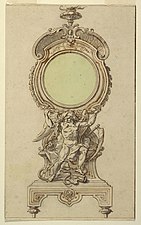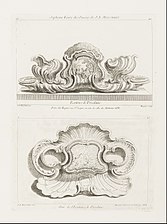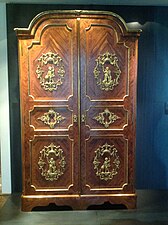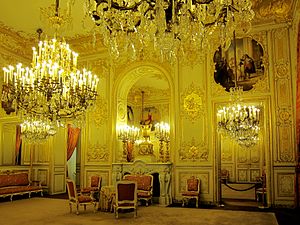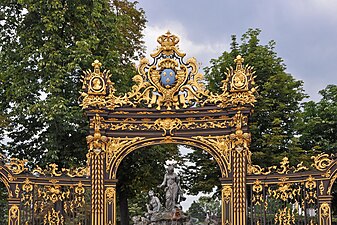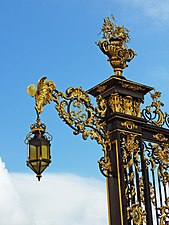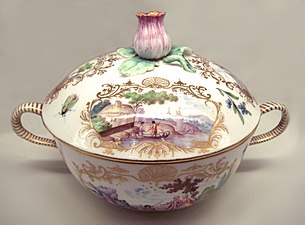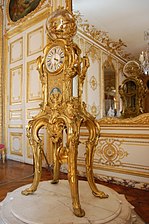Rocaille

Rocaille (
Overview
Rocaille was exuberant and inspired by nature like Rococo, but, unlike Rococo, it was usually symmetrical and not overloaded with decoration. It took its name from the mixture of rock, seashell and plaster that was used to create a picturesque effect in
The style was used particularly in salons, a new style of room designed to impress and entertain guests. The most prominent example was the salon of the Princess in
-
Design for a clock case by Gilles-Marie Oppenordt (1715)
-
Table design byJuste-Aurele Meissonier(c. 1730)
-
Design for the bedroom of the Prince,Hotel de Soubise, by Germain Boffrand(1735–1740)
-
Fireplace and mantle design by Nicolas Pineau (1st half of 18th century)
-
Designs for a porcelain writing set by Juste-Aurèle Meissonnier (1748)
-
Floral and acanthus leaf design by Alexis Peyrotte (1750)
Furniture
Rocaille decoration was heavily loaded with decoration modeled on seashells, cascades of leaves and flowers, palm leaves, and other natural elements. The decor on walls and furniture was usually made of carved wood or plaster which was gilded. The French designer Bernard Toro produced a book of flamboyant early Rocaille patterns in 1716, which was widely circulated in Europe. The first major craftsman in the style was
The master cabinet makers or ébénistes of rocaille furniture included Mathieu Criaerd (1689–1776), who became a master in 1738. He was particularly known both for his fine marquetry or inlay, and for his chests with a Chinese or Japanese theme, with fine Chinese lacquer or Martin varnish, and ornaments of gilded and sculpted bronze.[10]
Another important figure of the rocaille style was the ébéntiste
Other notable furniture craftsmen included the members of the Cresson family, Louis Cresson (1706–1761), Rene Cresson (1705–1749) and
-
Rocaille ornament of leaves, flowers and seashell
-
Louis XV Rocaille armoire (1725–1730) by Charles Cressent, (1725–1730)
-
Writing desk with Espagnolettes by Charles Cressent (1730–1735)
-
Commode by Charles Cressent (1730), Waddesdon Manor
-
Commode for the Dauphin by Mathieu Criaerd (1748)
-
Commode by Charles Cressent (1745–1749), Nelson-Atkins Museum of Art
Woodwork and interior decoration
Rocaille decoration was common in the wooden wall panels and other interior decoration between 1730 and 1750. The trim was usually made of carved and gilded wood or
-
Salon of the Hôtel de Soubise in Paris (1735–1740)
-
Woodwork in the Hôtel de Varengeville by Nicolas Pineau (1735)
-
Decoration on ceiling of office of the French Prime Minister, Hôtel Matignon (1720–1725)
-
Salon of the Hôtel de Lassay, now residence of President of the National Assembly
Silver, porcelain and metalwork
Besides its use in furniture, the style appeared in porcelain and metalwork. In 1738, the
The most remarkable rocaille metal work included the cast iron and gilded fences and gates created by iron maker Jean Lamour for the new Place Stanislas in Nancy between 1750 and 1758 as the Duchy of Lorraine was attached to France. The square was completed with an ensemble of buildings whose balconies and suspended lamps matched the grillwork of the fence and gates.[13]
-
Silver candelabra by Juste-Aurèle Meissonnier (1734–1735)
-
Frame for a wall clock by Jacques Caffieri (1745–1750)
-
Gilded cast-iron fence of Place Stanislas in Nancy (France) by Jean Lamour (1750–1758)
-
Gilded cast-iron lamp post of Place Stanislas in Nancy, France by Jean Lamour (1750–1758)
-
Gate with two statues and elaborate wrought-iron grilles, in Würzburg (Germany), grilles by Johann Georg Oegg (1752)
-
Vincennes soft porcelain with rocaille design and a Chinese scene (1749–1750)
-
Vase ofJean-Claude Duplessis(1753)
-
Astronomical clock of gilded bronze by Jacques Caffieri (1754), Museum of Versailles
-
Two Nymphenburg porcelain holy water fonts, model probably by Franz Anton Bustelli (around 1760)
Influence and decline
The Rocaille influenced the Chippendale style in England, and the work of the Belgian-born Bavarian decorative artist François de Cuvilliés. The style also became very popular for a time in Italy, particularly in Venice, and spread to Austria, Bavaria and Spain, where it took on a more exuberant and overcharged form.
The discovery of Greek antiquities beginning in 1738 at
See also
Notes and citations
- ^ "rocaille". The American Heritage Dictionary of the English Language (5th ed.). HarperCollins. Retrieved 2019-08-19.
- ^ "Rocaille". Collins English Dictionary. HarperCollins. Retrieved 2019-08-19.
- ^ "rocaille". Lexico UK English Dictionary. Oxford University Press. Archived from the original on 2021-04-15.
- ^ "rocaille". Merriam-Webster.com Dictionary. Retrieved 2019-08-19.
- ^ Larousse Encyclopedia on-line
- ^ a b Lovreglio 2006, p. 369.
- ^ Ducher 1988, p. 136.
- ^ De Morant, Henry, Histoire des arts décoratifs, p. 355
- ISBN 978-0-495-57355-5. Retrieved 2011-02-21.
- ^ a b Lovreglio 2006, p. 128.
- ^ Lovreglio 2006, p. 127.
- ^ Sèvres Porcelain Manufactory | People | Collection of Smithsonian Cooper-Hewitt, National Design Museum
- ^ De Morant 1970, p. 376.
Bibliography
- De Morant, Henry (1970). Histoire des arts décoratifs (in French). Librarie Hachette.
- Ducher, Robert (1988). Caractéristique des Styles (in French). Paris, France: Flammarion. ISBN 2-08-011539-1.
- Renault, Christophe (2006). Les Styles de l'architecture et du mobilier (in French). Paris, France: Gisserot. ISBN 978-2-877-4746-58.
- Wiegant, Claude-Paul (1995). Le Mobilier Français- Transition Louis XVI (in French). Paris, France: Massin. ISBN 2-7072-0281-9.
- Lovreglio, Aurélia and Anne (2006). Dictionnaire des Mobiliers et des Objets d'art du Moyen Âge au XXIe siècle (in French). Paris, France: Le Robert. ISBN 2-84902-079-6.

